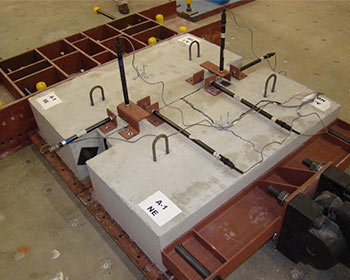MPC
Tie Bar Placement Research Could Improve Pavement Life and Reduce Maintenance
Posted: Sep 16, 2020
 MPC research in South Dakota regarding tolerances for tie-bar placement in concrete pavements could result in improved pavement service life and reduced maintenance costs. Longitudinal joints in Portland cement concrete (PCC) pavement slabs require tie (dowel) bars to control joint opening resulting from thermal stresses. Inspections of PCC pavements by the South Dakota Department of Transportation using ground penetrating radar revealed that it is common for tie bars to be either misplaced or completely missing at some locations. Tie-bar misalignment tolerances that have been established in existing specifications are not based on PCC pavement research or economic data. This research study investigates the effects of different tie-bar misalignments on the tie-bar performance to establish acceptable placement tolerances. In tests of 35 PCC pavement slabs, the researcher found that horizontal skew misalignment caused a significant increase in both joint opening and joint faulting. Based on the results, recommendations are to reduce the horizontal skew tolerance limit from 18 inches to no more than 16 inches.
MPC research in South Dakota regarding tolerances for tie-bar placement in concrete pavements could result in improved pavement service life and reduced maintenance costs. Longitudinal joints in Portland cement concrete (PCC) pavement slabs require tie (dowel) bars to control joint opening resulting from thermal stresses. Inspections of PCC pavements by the South Dakota Department of Transportation using ground penetrating radar revealed that it is common for tie bars to be either misplaced or completely missing at some locations. Tie-bar misalignment tolerances that have been established in existing specifications are not based on PCC pavement research or economic data. This research study investigates the effects of different tie-bar misalignments on the tie-bar performance to establish acceptable placement tolerances. In tests of 35 PCC pavement slabs, the researcher found that horizontal skew misalignment caused a significant increase in both joint opening and joint faulting. Based on the results, recommendations are to reduce the horizontal skew tolerance limit from 18 inches to no more than 16 inches.
Nadim Wehbe, Ph.D.
South Dakota State University
Tolerances for Placement of Tie Bars in Portland Cement Concrete Pavement
MPC-20-417

